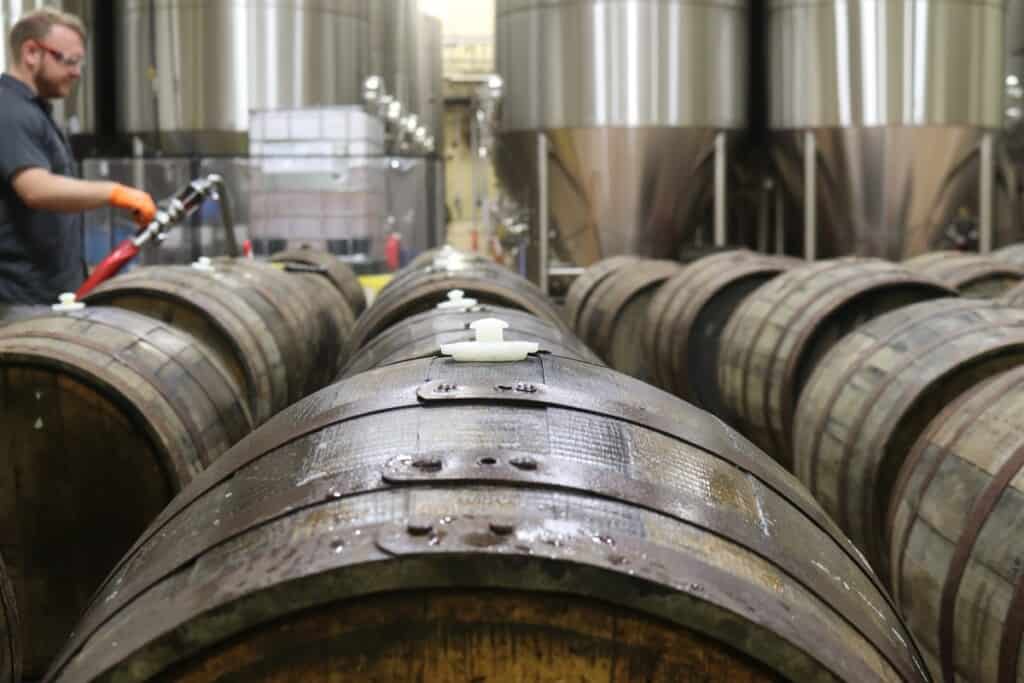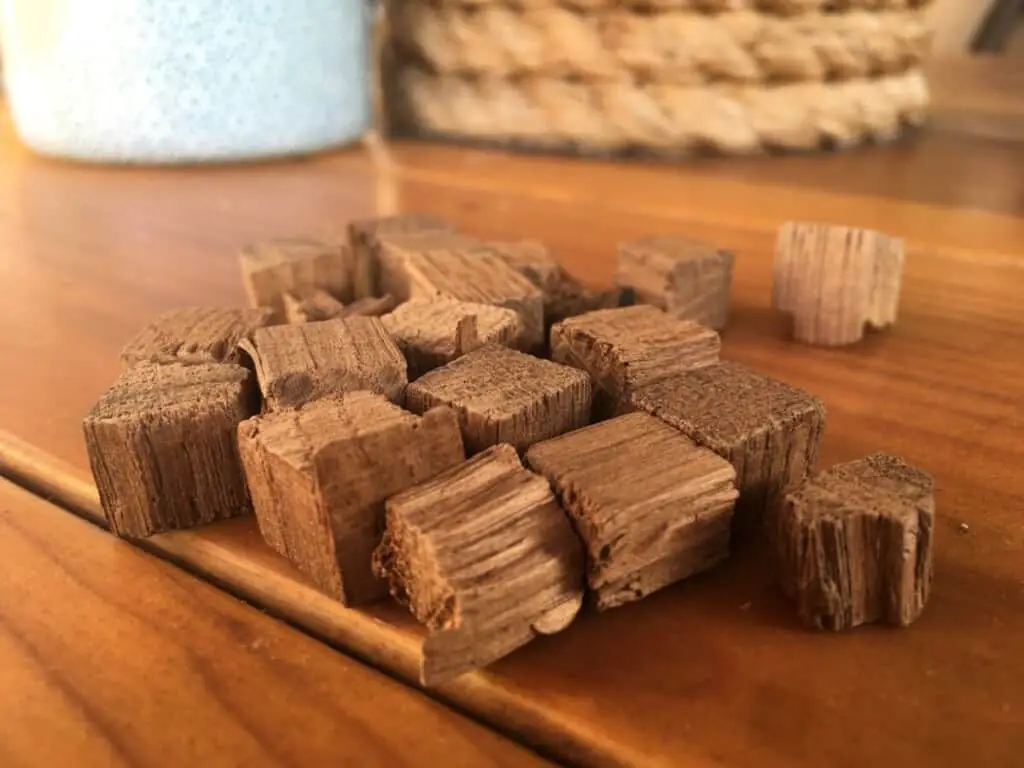I’m sure you’ve tried one before, a delicious barrel aged, malty beer. Your sitting at the bar, glancing back at the oak barrels the brewery uses to age and infuse the beer with that delicious oak flavor.

You probably could never achieve this at home, you think. But, I’m here to tell you that its possible.
You can impart oak flavor to your beer by using oak spirals, cubes, and chips. You don’t need to use a barrel to achieve a similar oak flavor to fermentation in oak barrels. Oak Spirals and chips can have different levels of char to produce various flavors, like vanilla or coffee.
While you might not be able to achieve quite the nuance that the professionals do, you can experiment and create something you like. Some breweries even use spirals themselves, even inside a barrel for quicker infusion.
Step 1. Deciding on Spirals, Chips or Cubes
There are many choices when it comes to deciding how you want to infuse your beer. There is really no right or wrong way when it comes down to it, except for efficiency and cost.
- Oak Spirals are the most efficient, but also the most expensive. The larger amount of surface area creates a quicker infusion, its also uniform and easier to recreate.
- Honey Comb Barrel Alternative a competitor to the oak spirals. It also claims the high surface area creates faster extraction rates. The quality of these don’t seem as great.
- Oak Cubes are the least efficient and also moderately expensive, but less per ounce than spirals. Many love to use cubes for their consistency.
- Oak Chips are the cheapest but also the least consistent. They might also end up floating so you will need to secure them in a bag with some weight.

It’s really up to how you want to use the oak, but the price for homebrewers is pretty negligible so I would go with the spirals for the added consistency. The oak spirals are also patented by a single company which makes the product consistent and dependable.
I would assume most major breweries use the spirals vs the other two methods since it reduces time. This is important for breweries since they need the space to turnover new product quickly.
Step 2. Decide on a Char Level and Wood Type
WAIT! Before you make up your mind and go run off to buy your oak, I need to tell you a little something about char levels. Oak barrels are charred for added complexity, depth and flavor. So, in order to recreate this, oak distributors char their products.
You will need to decide on what flavor profile you are looking for and purchase the appropriate char level. You will often see it called toast as well.
- Heavy toast tastes of smoke, toasted bread and dark chocolate.
- Medium plus has caramelized sugars that add honey and roasted nuts with some coffee notes. Mocha and chocolate are also noticeable.
- Medium toast has a vanilla compound rise in prominence.
- Light toast will have a coconut flavor and has high tannins.
The company Oak Infusion Spiral not only has these toast levels perfected, but they are experimenting with many exotic woods. I assume the more exotic woods can get pretty expensive and are to order only, so you might be better off sourcing your own exotic woods.
Some interesting woods I’ve seen are:
- Spanish Cedar
- Apple wood
- Spicy Amburana
- Cypress
- Sugar maple
Not only are exotic wood types and char levels something to worry about, but you also have wood from different regions.
- American oak is more robust and packs a bigger punch.
- French oak has a more subtle and nuanced flavor.
- Hungarian oak is between the American and French with a mellow flavor.
The price doesn’t really differ as far as the regions. But, may be a sliding scale according to popularity and scarcity. The price is more affected by the production method, spiral, chips etc.
Step 3. Decide on Oak Quantity Per Gallon
The quantity that you decide to add to your beer will vary according to your taste. The methods below are not an exact science, so its best to taste test in intervals.
- Infusion spiral suggests that 1 carboy sized spiral is good for 3 gallons of beer. Leave it in longer to extract more flavor.
- Oak cubes and chips are suggested to use 2 to 2.5 ounces.
It’s better to start with less than you might think you will need. You can always add more later or leave it in longer to extract more flavor.
Even if too much flavor is extracted you can just let it age and mellow out, just make sure you extract the oak from your carboy. It can be a bit tricky since the oak will expand so it may be worthwhile to use a wide mouth carboy.
Step 4. Infuse Oak into Your Beer in Secondary or Primary
You might be wondering what the best type of beer is for adding oak. Well, traditionally higher abv stouts or any other maltier beers are great choices. But, today brewers are adding oak to anything and everything so feel free to experiment to your hearts content.

The process for adding oak to your beer is fairly simple, however there are some fears when it comes to contamination. The good news is that if you purchased your oak and it came in a sealed bag you are good to go, toss it in and let it impart flavor.
However, if you made and toasted your own oak you might want to either add it to a liquor, like vodka or whiskey. Let it soak for 1 day and then add it. You will also need to add the liquor along with it, as not to miss any of the oak goodness. Also to toasting process should kill bacteria and other bugs as well.
When adding your oak do the following:
- Either add the oak to primary or secondary. Secondary is more common since fermentation may interfere with the flavor.
- Oak Spirals should sink buts its best to add spirals, cubes, and chips to a muslin bag with some sanitized marbles so its fully submerged.
- Let sit for 3-4 weeks depending on your choice of product and quantity. Make sure to taste it for your personal preference and bottle when finished.
One reason why higher abv beer styles are chosen for oak additions is they are better for aging, and higher levels of hops tend to oxidize and do not do well over time.
Step 5. Enjoy Your Beer and Mix with Future Batches for Variety
It’s really not that difficult to make a delicious oak flavored and aged beer. The hardest part is the wait. One method many sour aficionados partake in is mixing their beers.
Mixing a young and older beer results in something nice and mellow. It can also help to offset any mistakes that you may have made. This way you don’t have to toss a whole batch but can get a new delicious flavor.
I wouldn’t mix beer styles but rather make sure you have the same base recipe and experiment with char levels or wood types.
Re-use Oak Chips at Your Own Risk
You can actually reuse oak chips, you just need to make sure they are sanitized for their next use. Also pay close attention to how long you used the last ones.
The oak spirals will have a max extraction of about 6 weeks, so if you have already used it for six weeks there is no point in reusing the oak chips as you wont get much flavor.
Learn More and Start Brewing With Oak
If you are interested in learning more about brewing with oak and learning all of the tiny details you can check out Wood and Beer: A Brewers Guide.
Whether you are brewing with extract or brewing all-grain you can still experiment with wood flavorings. In fact this extract kit allows you to brew a whisky barrel stout and comes with oak chips.
It is a bit expensive by our frugal standards so when your ready check back here and learn how to brew all-grain and consider bookmarking this page.

